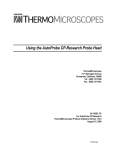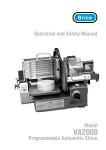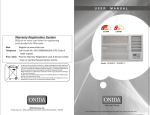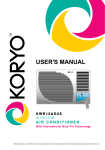Download T-Lift - Trail Master Outdoors
Transcript
T-Lift Instruction Manual Lifting jaw T-bar Pin, washer and safety clip Figure 1 Patent No. US 7,192,007 B2 For use with Ford F 250 & F 350 model vehicles. Fits model years ‘99 to current model without modification to vehicle. For proper use and safety, read entire Instruction Manual before using the T-Lift. www.tliftonline.com (208) 670-5580 Revised 2/2008 1 Figure 2 View looking down/through truck bed to axle and vehicle frame Rear wheels Rear bumper T-bar Lifting Jaw Hitch lifting point Pin Jack How to Operate the T-Lift: 1. Rear of Vehicle (see figure 2) a. Chock* front tires. b. Insert T-Lift securely into hitch lifting point of vehicle. c. Check that lifting jaw is securely fastened with pin to the T-bar portion of the T-Lift d. Insert Jack completely into lifting jaw. e. Ensure that base of Jack is on a surface capable of sustaining the load and that Jack is vertical. Refer to your Jack manual for proper use of Jack. f. When vehicle is fully lifted off ground, stabilize load by blocking** lifted portion of vehicle. g. To lower vehicle, reverse operation of Jack and carefully lower vehicle until all four tires are securely on ground. Remove Jack from lifting jaw and remove T-Lift from vehicle lifting point. *A chock is a wedge for steadying vehicle and holding it motionless, or preventing the movement of a wheel. **When you block a load, you secure and support a load that is being lifted. The block(s) or stabilizer(s) should have a weight capacity that is greater than the weight of the load which is being lifted. 2 Figure 3 Front profile view of vehicle Figure 4 Enlargement of circled area in Figure 3 Pin, washer & Safety clip Jack T-Lift Lifting Jaw Front Bumper Front Pull Ring 2. Lifting Front of Vehicle (see figures 3 & 4) a. Chock and block rear tires. b. Insert lifting jaw of T-lift into vehicle’s front pull ring. c. Secure pin in place with washer and safety clip. d. Insert Jack completely into T-Lift lifting jaw. e. Ensure that base of Jack is on a surface capable of sustaining the load and that Jack is vertical. Refer to your Jack manual for proper use of Jack. f. When vehicle is fully lifted off ground, be sure to stabilize load by blocking lifted portion of vehicle. g. To lower vehicle, reverse operation of Jack and carefully lower vehicle until all four tires are securely on ground. Remove Jack from lifting jaw and remove T-Lift from vehicle lifting point. 3 Front Bumper Safety: • • • • • Carefully inspect T-Lift before use. Do not use T-Lift if any parts are missing or damaged, including pin. Secure Jack on a surface capable of sustaining vehicle’s load; refer to your Jack user’s manual for any questions regarding use of Jack. If you have any further questions after reviewing operating instructions, contact us on our website, www.tliftonline.com, or call (208) 670-5580 before attempting to lift vehicle. Our website has an instructional video demonstrating the proper usage of the T-Lift. For any questions regarding your Jack, refer to your Jack’s manufacturer for all safety and operating instructions. Inspection: • • Before using the T-Lift, a visual inspection should be made to ensure there are no cracked welds, damaged, loose or missing parts. If the T-Lift is damaged in any way or operates abnormally, it must be removed from service immediately. Please contact us for any replacement parts or possible repair of T-Lift. Alteration: To insure safe operation of the T-Lift, no alterations or modifications should be made to the T-Lift. Warnings: • • • • • The T-Lift is a lifting device that should be used in conjunction with a Jack to safely lift the above listed Vehicle models only (page 1) and should not be used in any other capacity. Do not attempt to move vehicle while vehicle is lifted or in any other way connected to the T-Lift. Secure Jack on a surface capable of sustaining vehicle’s load. The T-Lift and Jack should not be used on a grade which would result in Jack instability and/or possible loss of vehicle’s load. The T-Lift is not meant to stabilize the vehicle; you must chock and block the vehicle to stabilize the load to prevent the vehicle from moving. 4












